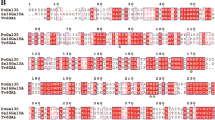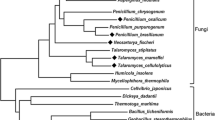Abstract
The main form of pectate hydrolases in the cell wall of parsley roots showed a unique substrate preference of a plant exopolygalacturonase because it clearly preferred the substrates with degree of polymerization about 10. This form was separated from the others, purified and characterized. Enzyme exhibited sharp pH optimum corresponding to pH 4.7, molecular mass 53.5 kDa, and isoelectric point 5.3. It was stable at 50°C in 2-h assay and had optimum of temperature at 60°C (activation energy being 37.0 kJ/mol). The interaction with concanavalin A indicated the glycosylation of enzyme. Substrates were cleaved from the non-reducing end.
Similar content being viewed by others
Abbreviations
- α-MMP:
-
methyl-α-d-mannopyranoside
- DP:
-
degree of polymerization
- exoPG:
-
exopolygalacturonase
- GH:
-
glycoside hydrolase
- HG:
-
homogalacturonan
- OGH:
-
oligogalacturonate hydrolase (oligogalacturonase)
- OGH6:
-
OGH preferring hexagalacturonate
- OGH10:
-
OGH with preference for decamer
- PG:
-
polygalacturonase
- RG I:
-
rhamnogalacturonan I
References
Abbott D.W. & Boraston A.B. 2007. The structural basis for exopolygalacturonase activity in family 28 glycoside hydrolase. J. Mol. Biol. 368: 1215–1222.
Biely P., Benen J., Heinrichová K., Kester H.C. & Visser J. 1996. Inversion of configuration during hydrolysis of α-1,4-galacturonic linkage by three Aspergillus polygalacturonases. FEBS Lett. 382: 249–255.
Bradford M.M. 1976. A rapid and sensitive method for the quantitation of microgram quantities of protein utilizing the principle of protein-dye binding. Anal. Biochem. 72: 248–254.
Carpita N.C. & Gibeaut D.M. 1993. Structural models of primary cell walls in flowering plants: consistency of molecular structure with the physical properties of the walls during growth. Plant J. 3: 1–30.
Cho S.W., Lee S. & Shin W. 2001. The X-ray structure of Aspergillus aculeatus polygalacturonase and a modeled structure of the polygalacturonase-octagalacturonate complex. J. Mol. Biol. 314: 863–878.
Dzúrová M., Linek K. & Stratilová E. 1995. Inhibition of exopolygalacturonase from carrots by reaction products and by their basic analogues. Biologia 50: 595–599.
Federici L., Caprari C., Mattei B., Savino C., Di Matteo A., De Lorenzo G., Cervone F. & Tsernoglou D. 2001. Structural requirements of endopolygalacturonase for the interaction with PGIP. Proc. Natl. Acad. Sci. USA 98: 13425–13430.
Flodrová D., Dzúrová M., Lišková D., Ait Mohand F., Mislovičová D., Malovíková A., Voburka Z., Omelková J. & Stratilová, E. 2007. Pectate hydrolases of parsley (Petroselinum crispum) roots. Z. Naturforsch. 62c: 382–388.
Garcia-Romera I. & Fry S.C. 1995. The longevity of biologicallyactive oligogalacturonides in rose cell cultures. Degradation by exo-polygalacturonase. J. Exp. Botany 46: 1853–1857.
Hatanaka C. & Ozawa J. 1964. Enzymic degradation of pectic acid. I. Limited hydrolysis of pectic acids by carrot exopolygalacturonase. Agric. Biol. Chem. 28: 672–632.
Hasegawa S. & Nagel C.W. 1968. Isolation of an oligogalacturonate hydrolase from a Bacillus specie. Arch. Biochem. Biophys. 124: 513–520.
Heinrichová K. 1977. Isolation, characterization and mode of action of exo-d-galacturonanase from carrot. Collect. Czech. Chem. Commun. 42: 3214–3221.
Heinrichová K. 1983. Preparation of oligogalacturonic acids by enzymatic hydrolysis. Biologia 38: 335–342.
Heinrichová K., Heinrich J., Dzúrová M. & Ziolecki A. 1993. Mode of action and partial purification of the active centre of exopoly-α-d-galacturonosidase from Selenomonas ruminantium. Collect. Czech. Chem. Commun. 58: 681–692.
Heinrichová K. & Rexová-Benková L’. 1976. Purification and characterization of an extracellular exo-d-galacturonanase of Aspergillus niger. Biochim. Biophys. Acta 422: 349–356.
Henrissat B. 1991. A classification of glycosyl hydrolases based on amino-acid-sequence similarities. Biochem. J. 280: 309–316.
Henrissat B. & Davies G. 1997. Structural and sequence-based classification of glycoside hydrolases. Curr. Opin. Struct. Biol. 7: 637–644.
Kester H.C.M., Kusters-van Someren M.A., Müller Y. & Visser J. 1996. Primary structure and characterization of an exopolygalacturonase from Aspergillus tubigensis. Eur. J. Biochem. 240: 738–746.
Kohn R. & Furda I. 1967. Calcium ion activity in solutions of calcium pectinate. Collect. Czech. Chem. Commun. 32: 1925–1937.
Kohn R. & Luknár O. 1977. Intermolecular calcium ion binding on polyuronates — polygalacturonate and polyguluronate. Collect. Czech. Chem. Commun. 42: 731–744.
Koller A. & Neukom H. 1964. Detection of oligogalacturonic acids by thin-layer chromatography. Biochim. Biophys. Acta 83: 366–367.
Liao C.H., Revear L., Hotchkiss A. & Savary B. 1999. Genetic and biochemical characterization of an exopolygalacturonase and pectate lyase from Yersinia enterocolitica. Can. J. Microbiol. 45: 396–403.
Markovič O. & Janeček Š. 2001. Pectin degrading glycoside hydrolases of family 28: sequence-structural features, specificities and evolution. Protein Eng. 14: 615–631.
Martens-Uzunova E.S., Zandleven J.S., Benen J.A.E., Awad H., Kools H.J., Beldman G., Voragen A.G.J., van den Berg J.A. & Schaap P.J. 2006. A new group of exo-acting family 28 glycoside hydrolases of Aspergillus niger that are involved in pectin degradation. Biochem. J. 400: 43–52.
Musell H.W. & Strouse B. 1972. Characterization of two polygalacturonases produced by Verticillium albo-atrum. Can. J. Biochem. 50: 625–632.
Niture S. 2008. Comparative biochemical and structural characterizations of fungal polygalacturonases. Biologia 63: 1–19.
Parenicová L., Kester H.C.M., Benen J.A.E. & Visser J. 2000. Characterization of a novel endopolygalacturonase from Aspergillus niger with unique kinetic properties. FEBS Lett. 467: 333–336.
Pickersgill R., Smith D., Worboys K. & Jenkins J. 1998. Crystal structure of polygalacturonase from Erwinia carotovora ssp. carotovora. J. Biol. Chem. 273: 24660–24664.
Pressey R. & Avants J.K. 1975. Modes of action of carrot and peach exopolygalacturonases. Phytochemistry 14: 957–961.
Radola B.J. 1980. Ultrathin-layer isoelectric focusing in 50–100 μm polyacrylamide gels on silanized plates or polyester films. Electrophoresis 1: 43–56.
Rayle D.L. & Cleland R.E. 1992. The acid growth theory of auxin-induced cell elongation is alive and well. Plant Physiol. 99: 1271–1274.
Rexová-Benková L’. 1970. Separation of oligogalacturonic acids by dextran gel chromatography. Chem. Zvesti 24: 59–62.
Rexová-Benková L’. & Markovič O. 1976. Pectic enzymes. Adv. Carbohydr. Chem. Biochem. 33: 323–385.
Shimizu T., Nakatsu T., Miyairi K., Okuno T. & Kato H. 2002. Active-site architecture of endopolygalacturonase I from Stereum purpurum revealed by crystal structures in native and ligand-bound forms at atomic resolution. Biochemistry 41: 6651–6659.
Somogyi M. 1952. Notes on sugar determination. J. Biol. Chem. 195: 19–23.
Stratilová E., Dzúrová M., Breierová E. & Omelková J. 2006. Production and biochemical characterization of polygalacturonases produced by Aureobasidium pullulans from forest soil. Ann. Microbiol. 56: 35–40.
Stratilová E., Dzúrová M., Malovíková A. & Omelková J. 2005. Oligogalacturonate hydrolase from carrot roots. Z. Naturforsch. 60c: 899–905.
Stratilová E., Mislovičová D. & Dzúrová M. 1996. Purification of exopolygalacturonase by affinity chromatography on concanavalin A — bead cellulose. Biotechnol. Tech. 10: 363–366.
Torki M., Mandaron P., Mache R. & Falconet D. 2000. Characterization of a ubiquitous expressed gene family encoding polygalacturonase in Arabidopsis thaliana. Gene 242: 427–436.
van Pouderoyen G., Snijder H.J., Bennen J.A. & Dijkstra B.W. 2003. Structural insights into the processivity of endopolygalacturonase I from Aspergillus niger. FEBS Lett. 554: 462–466.
Van Rijssel M., Smidt M.P., van Kouwen G. & Hansen T. 1993. Involvement of an intracellular oligogalacturonate hydrolase in metabolism of pectin by Clostridium thermosacchrolyticum. Appl. Environ. Microbiol. 59: 837–842.
van Santen Y., Bennen J.A., Schroter K.H., Kalk K.H., Armand S., Visser J. & Dijkstra B.W. 1999. 1.68 Å crystal structure of endopolygalacturonase II from Aspergillus niger and identification of active site residues by site-directed mutagenesis. J. Biol. Chem. 274: 30474–30480.
Vincken J.P., Schols H.A., Oomen R.J., Beldman G., Visser R.G.F. & Voragen A.G.J. 2003a. Pectin — the hairy thing, pp. 47–50. In: Voragen A.G.J., Schols H.A. & Visser R.G.F. (eds), Advances in Pectin and Pectinase Research, Kluwer Academic Publishers, Dordrecht.
Vincken J.P., Schols H.A., Oomen R.J., McCann M.C., Ulvskov P., Voragen A.G.J. & Visser R.G.F. 2003b. If homogalacturonan were a side chain of rhamnogalacturonan I. Implications for cell wall architecture. Plant Physiol. 132: 1781–1789.
Voragen A.G.J., Pilnik W., Thibault J.F., Axelos M.A.V. & Renard C.M.G.C. 1995. Pectins, pp. 287–339. In: Stephen A.M. (ed.), Food Polysaccharides, Dekker, Inc., New York-Basel-Hong Kong.
Wray W., Boulikas T., Wray V.P. & Hancock R. 1981. Silver staining of proteins in polyacrylamide gels. Anal. Biochem. 118: 197–203.
Author information
Authors and Affiliations
Corresponding author
Rights and permissions
About this article
Cite this article
Flodrová, D., Garajová, S., Malovíková, A. et al. Oligogalacturonate hydrolase with unique substrate preference from the pulp of parsley roots. Biologia 64, 228–234 (2009). https://doi.org/10.2478/s11756-009-0038-2
Received:
Accepted:
Published:
Issue Date:
DOI: https://doi.org/10.2478/s11756-009-0038-2




